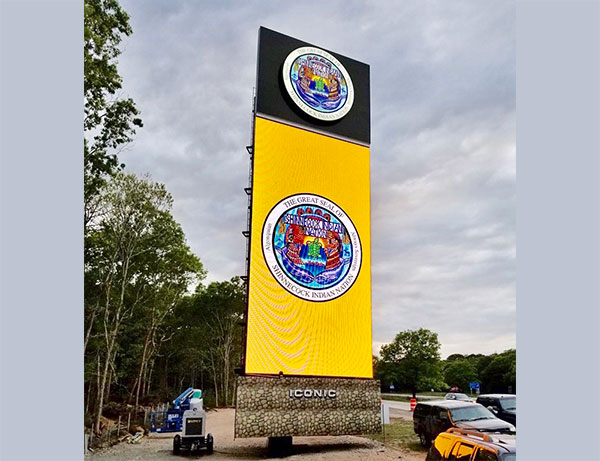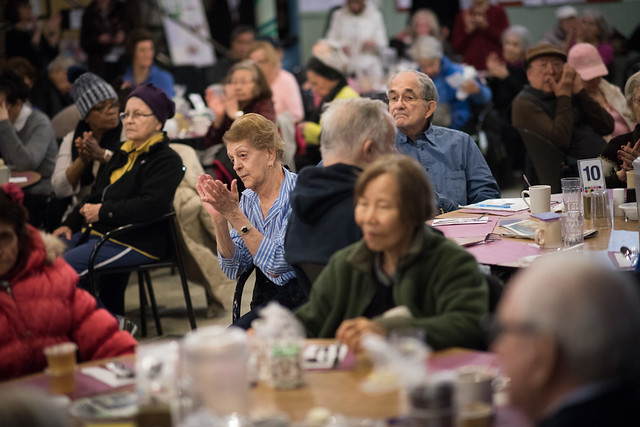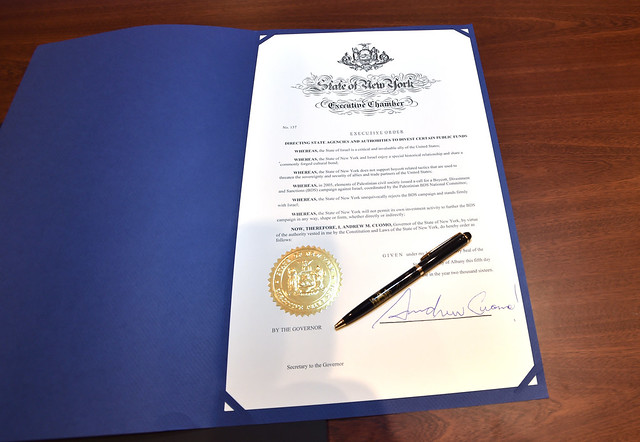A Monument to an Indigenous Future, Worthy of Attorney General James’ Support

The Shinnecock billboard on Route 27 (photo via a Shinnecock Nation member)
New York State Attorney General Letitia James earned a reputation as a relentless fighter for working people in the Brooklyn gentrification struggles of the early 21st century. Representing parts of Fort Greene, Clinton Hill, Crown Heights, Prospect Heights, and Bedford-Stuyvesant in the early 2000s, City Council Member James insisted that low-income and working people must have a place and a future in Brooklyn.
Block by block, James helped community members keep their homes and businesses in a context where the rent -- tied to the speculative dreams of wealthy investors and not to the livelihoods of current residents -- was always rising. James's office supported my own rent battle in Crown Heights from 2005 to 2010.
But now, in her new statewide role as Attorney General, James is threatening the land rights of a community that has resisted and survived one of the original, violent processes of forced displacement in United States history. Why?
The Shinnecock Nation of Eastern Long Island is facing legal threats from the state Department of Transportation (DOT) and the State of New York for launching a billboard project on tribal land.
The advertising revenue from two 60-foot electronic billboards on either side of Route 27, known as Sunrise Highway, at Hampton Bays is slated to support health and dental clinics, a community daycare facility, and other projects for the Shinnecock community.
The town of Southampton, the Shinnecock's nearest neighbor since 1640, has deemed the billboards a driver distraction, an aesthetic blight, a detraction from the 'character' of the Hamptons, and has enlisted the DOT to stop the project.
The irony of Southamptonites' pearl-clutching in response to the Shinnecock’s modest attempt to chart a path toward economic survival, and not to the McMansions, the private jets, the environmental disaster of a golf course, and all manner of excess that characterize the Hamptons development trajectory is laughable, but not surprising. For generations, Southampton town has insisted that the Shinnecock should play a particular role (read: silent, servile, picturesque) in their shared community.
And yet, the Shinnecock Nation's decision to use its land as its members wish is their right, the result of 32 years of successful struggle to become a federally-recognized Indian nation; NIMBY doesn't work when it is not actually your backyard. The legal battle involving this only highway into the Hamptons tests the solidity of federal tribal sovereignty rights against a monied community’s belief that the future of the Hamptons is theirs alone to dream and develop.
Supporting the Shinnecock are the National Congress of American Indians (NCAI) and others who recognize that the survival of indigenous communities will require new, creative, and unapologetic assertions of sovereignty. In many parts of the country, state or federal highways run across tribal land. These thoroughfares are spatial evidence of a history of violent displacement but they also offer economic opportunities for native communities. By foregoing local or state permits, the Shinnecock root their economic development project in their hard-won federal legal status; and well they should. State and local courts have historically lacked the precedents or courage to support indigenous economic self-determination. The problem of so-called “home cooking” in biased state courts is legendary in federal Indian law jurisprudence.
Given her 2018 election as the state’s chief legal officer, Letitia James has an opportunity to move Albany beyond the acrimony that predates her, and has long characterized the relationship between New York State and the Shinnecock Nation.
James had spoken of a desire to use the law to fight for all New Yorkers; there are few politicians who better understand the right to space as a key battleground for creating opportunity and equity. However, the entanglement of economic marginalization and geographic displacement looks different in the state versus the city contexts. Here, the "neighborhood" is the curling whippet of land along the Peconic Bay; "gentrification" has looked alternately like genocide, golf courses, and greenwashing (among other things) over the past five centuries.
A phenomenon that native scholars have coined “indigenous erasure” helps explain why the Shinnecock billboard project faces such opposition in eastern Long Island, why few in the New York City-Hamptons circuit have spoken out about this issue, and why a progressive fighter like James has not yet reached out to the Shinnecock Nation, choosing instead to maintain the state’s track record of relating to this community through lawsuits and threats.
I live in eastern Long Island, where indigenous names dot the landscape from Montauk to Massapequa and yet non-native communities are defensive or downright hostile when asked to acknowledge the indigenous present or make room for an indigenous future. Southampton Supervisor Jay Schneiderman’s claim that "[the billboards] will completely change the character of the community we have fought long to protect" reflects a jarring sense of entitlement; 500 years of settler history will do that to you.
In these parts, people wonder out loud why the Shinnecock can’t think of anything beyond cigarettes and billboards to earn money -- which is really a way of insisting that the Shinnecock future must follow a course pre-approved by the settlers in their midst who know little about the Nation and care even less. In my area, people crow loudly that this billboard project is the Shinnecock “straying from their culture”-- which is really a way of saying that externally-generated stereotypes of American Indians are more authentic than the voices of actual living indigenous people. ‘Why can’t they just follow the law?’ I have heard. ‘This is not about race, it’s the law!’ But this too is a smokescreen, a bemusing disregard of the copious evidence that U.S. law, particularly where land is concerned, has never been color- or power-blind.
And yet, with all deliberation and speed the Shinnecock Nation moves forward to pursue an economic future despite being largely excluded from the wealth streams of the Hamptons development machine. And so Shinnecock tribal elders have deemed these billboards a monument. They have claimed them as works of art and justice, as a tangible symbol of the Nation’s effort to choose how it is represented in public and to determine its economic trajectory.
As a historian, I understand the multivalent work of monuments -- the way they preserve and petrify particular narratives in their heavy materials. So this past July 4 at sunrise, I joined my Shinnecock neighbors at this monument as an act of solidarity and gratitude for their work of art and faith. I almost hoped to see Attorney General James there. I’ll be looking out for her on Labor Day Weekend at the 72nd Annual Shinnecock Pow Wow.
***
Dr. Abena Ampofoa Asare is Associate Professor of Africana Studies and History at Stony Brook University (SUNY). She is the author of Truth Without Reconciliation: A Human Rights History of Ghana (University of Pennsylvania, 2018).
***
Have an op-ed idea or submission for Gotham Gazette? Email This email address is being protected from spambots. You need JavaScript enabled to view it.
Protecting Aging New Yorkers Amid Growing Threats Posed by Extreme Heat

(photo: Michael Appleton/Mayoral Photography Office)
In a city where flooding is the face of climate change, extreme heat is a silent but growing threat. Every year, extreme heat in New York City causes, on average, more than 450 emergency room visits and 150 hospital admissions, and results in the deaths of 115 New Yorkers from heat stroke and heat-related exacerbation of chronic health conditions. Older people are at the most risk.
For the first time in human history, our planet has more people over 65 than children under five, and the world’s global population is concentrating in cities. New York exemplifies both demographic shifts.
The city’s largest landlord, the New York City Housing Authority (NYCHA), has approximately 62,000 residents aged 65 years and older, and seniors continue to be the public housing authority’s fastest growing population. Research shows that during heat waves older people suffer worse outcomes than the general population when air conditioning is not available or fails due to power outages. This makes it critical that the city augment its current cooling strategies.
As heat waves continue to increase in frequency and intensity, a new report commissioned by NYCHA recommends ways to protect the city’s most at-risk population. Sheltering Seniors from Extreme Heat compares the benefits and costs of a variety of physical upgrades, including energy efficient façades, mechanical cooling, and onsite generator backup, and provides a list of sustainable improvements that would allow NYCHA’s senior residents to remain safely at home during summer heat waves and power outages.
Arup’s study of NYCHA senior housing units reveals that, in the absence of air conditioning, indoor air temperatures rise dangerously high during heat waves and that upgrading building envelopes is not enough to remedy the problem. To ensure adequate cooling, these upgrades must be supplemented with backup power. Analyses comparing partial backup of critical systems to full-site backup found that the latter increases comfort and that implementation is less disruptive to NYCHA residents’ daily activities.
NYCHA recently launched a new cooling system initiative in response to the report. The smart air-conditioning pilot project is currently underway at Meltzer Tower, a NYCHA senior building in Manhattan. As part of the project, each of the building’s cooling units will be linked to a networked central control system for a safe and efficient service during dangerous heatwaves.
Another pilot project designed to test the feasibility of heat-pumps as an environmentally sustainable alternative to gas is slated to launch this summer. Seven apartments at the Fort Independence Houses in the Bronx will have their gas-fired hot water heating replaced by an electric heat-pump system that can also deliver cooling.
Smart and electrified cooling systems offer a great opportunity for New York City to meet its ambitious goal to reduce carbon emissions by 80 percent before 2050, while ensuring that senior residents can remain comfortably and safely in their own homes during a heatwave or blackout. As the landlord to more than 400,000 city residents, NYCHA has an important role to play in safeguarding New York’s senior population and is paving the way to make New York a safer, more heat-resilient city.
***
Pallavi Mantha is Senior Energy and Sustainability Consultant at Arup. On Twitter @PallaviMantha of @ArupGroup.
***
Have an op-ed idea or submission for Gotham Gazette? Email This email address is being protected from spambots. You need JavaScript enabled to view it.
Equifax Data Breach Highlights Corporations’ Troubling Use of Mandatory Arbitration and Need for Reform

(photo: Kevin P. Coughlin/Office of Governor Andrew M. Cuomo)
Recently, Governor Andrew Cuomo and Attorney General Letitia James announced that New York will receive $19 million from Equifax as part of a broader $700 million settlement for a massive data breach that took place in 2017. This settlement represents a clear victory for civil justice, but it also highlights how major corporations use underhanded mandatory arbitration policies to deny accountability and recourse to consumers.
When news of the data breach first broke in fall of 2017, Equifax attempted to make amends by offering a year of identity theft protection services to affected customers. But this offer came with a startling catch – under the required terms, which could not be negotiated by the customer, affected customers were prohibited from joining collective lawsuits against the company, and instead were required to accept “mandatory arbitration.”
“Mandatory arbitration,” the legal clause wielded by Equifax in its offer of “free” identity theft protection, is widely used by companies as a shield from the civil justice system. Further, it is often buried in cumbersome contractual language (the “terms and conditions” people blindly agree to when they buy something online or even use a coupon), which is more often than not overlooked by consumers until it is too late.
Why is mandatory arbitration a scourge to consumers and victims?
The mandatory arbitration clause strips victims of their right to a trial by jury, which is guaranteed by the 7th amendment, and instead resolves victims’ claims through a private process with an arbitrator and arbitration association selected by the corporation. These arbitration associations routinely do business with the corporation and owe their loyalty not to the interest of justice, but to that corporation.
Moreover, victims are up against powerful corporations with overwhelming resources, and in an arbitration everyday working New Yorkers are no match for a team of high-powered, professional defense attorneys, who will sit across from the consumer at a large, intimidating conference table, hammering home their points. Further, in mandatory arbitration evidence and outcomes are shielded from public scrutiny and wrongdoers are able to hide their bad acts.
Our country’s civil justice system is designed to hold companies and industries responsible when their actions cause harm to consumers and employees. In a court of law, victims of negligence, discrimination, and malpractice have an opportunity to address corporate transgressions.
For that reason, it’s important that consumers have avenues to justice unencumbered by mandatory arbitration policies. It’s critical that those affected by corporate negligence can hold bad actors accountable. Under mandatory arbitration, perpetrators can escape scrutiny by burying individual claims in paperwork and litigation costs.
In practice, the civil justice system has forced companies and organizations to address wrongdoings, compensate victims, and correct institutional flaws. When mandatory arbitration has been removed from the picture, civil courts have successfully helped to limit deceptive tobacco advertising, protect people from toxic chemicals, and even make our cars safer.
Mandatory arbitration is a sham, intended to stifle cries of injustice and protect a company’s bottom line. Moreover, this assault on the right to trial has crept into all types of contracts, including the agreement you sign with the nursing home for your elderly parent as well as the items and services you may buy online.
In the wake of the Equifax scandal and countless others like it, it is imperative that our state and federal lawmakers stand up for consumers’ legal rights.
The concept and practice of mandatory arbitration is an offense against the public interest. It’s time for big business to end the use of mandatory arbitration, or risk being held accountable for using this shameful and deceitful practice to rip off everyday Americans.
***
Michele Mirman is President of the New York State Trial Lawyers Association. On Twitter @NYSTLA.
***
Have an op-ed idea or submission for Gotham Gazette? Email This email address is being protected from spambots. You need JavaScript enabled to view it.




